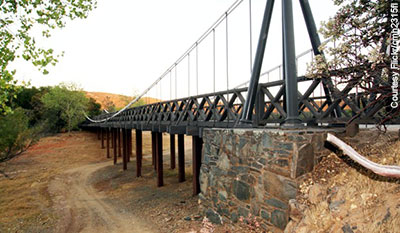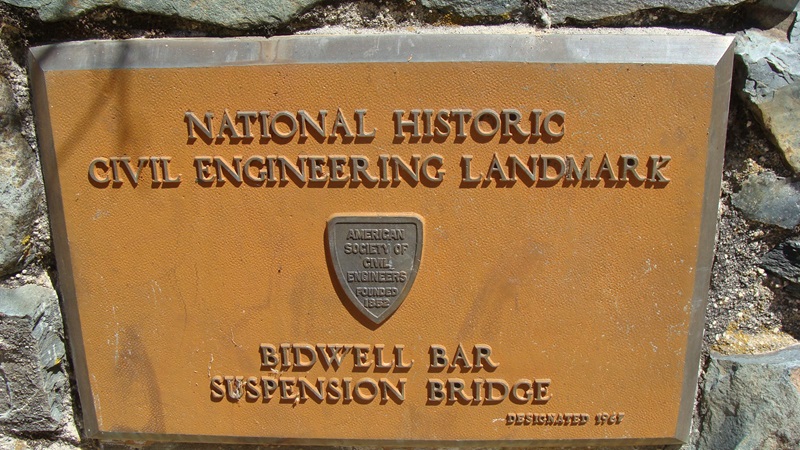Bidwell Bar Suspension Bridge
39 32 14.8 N, 121 27 15.6 W

Typical of the suspension bridges constructed during California gold rush days, the Bidwell Bar Suspension Bridge is the only remaining suspension bridge of its time in the West.
"The beautiful and substantial structure is one which does full credit to the bridge company and the contractor Capt. Jas. A. Murray."
- Letter to Editor that appeared in the North Californian, January 9, 1856
Soon after gold was discovered at Sutter's Mill near Sacramento in 1848, General John Bidwell found gold near the Middle Fork of the Feather River. His discovery brought hordes of miners to the scene and Bidwell Bar was born. The Bidwell Bar Suspension Bridge over the Feather River was one of several suspension bridges built in the region in the 1850s, and is the only one that remains.
Wire ropes had been developed only within the decade before construction. Pioneer engineers brought these advances to California and designed, ordered the material, and constructed the bridge in the remote frontier. Almost all the material used to build the bridge was brought "around the horn" (i.e. fabricated on the East Coast and shipped around Cape Horn to California).
Facts
- Travelers crossed the river by ferry before the Bidwell Bar Suspension Bridge was built. The ferry cost 25 cents to cross on foot, $1.50 for a light wagon, and $2.00 for a heavy wagon.
- The Court of Sessions licensed the original Bidwell Bar Toll Bridge in May 1851. That bridge was destroyed in April 1852. In December 1854 a license was granted to the Bidwell Bridge Company to build a toll suspension bridge.
- The bridge was built by Jones and Murray, contractors in Sacramento. The total cost of the structure was $34,922.
- The original components of the bridge were primarily wrought iron and cast iron from Troy, New York
- There were four cables, two on each side. Each cable was seven inches in diameter and made up of about 300 No. 10 wires laid in parallel strands. Each bundle was then spirally wrapped with a wrought iron wire, and the entire cable was coated with paint
- The cables were anchored to bent bars, which were cemented into recesses in the rock embankment. The anchorages were originally thought to be bent wrought iron bars packed in oil. When the bridge was repaired in the early 1900s and the anchors scraped to remove rust, they were found to be bronze, not iron.
- Each tower consisted of four cast iron posts, each measuring about 20 inches at the base, tied together with a cross of cast iron plate at the base. The Starbuck Iron Works of Troy New York manufactured the piers.
- The bridge was in use until after World War II, when a new bridge was built to carry vehicular traffic. In 1964, the bridge was dismantled to make way for the Oroville Reservoir. Local crews relocated the bridge and adjoining tollhouse to Bidwell Canyon on the south end of Lake Oroville, 1.5 miles downstream from their original location.


